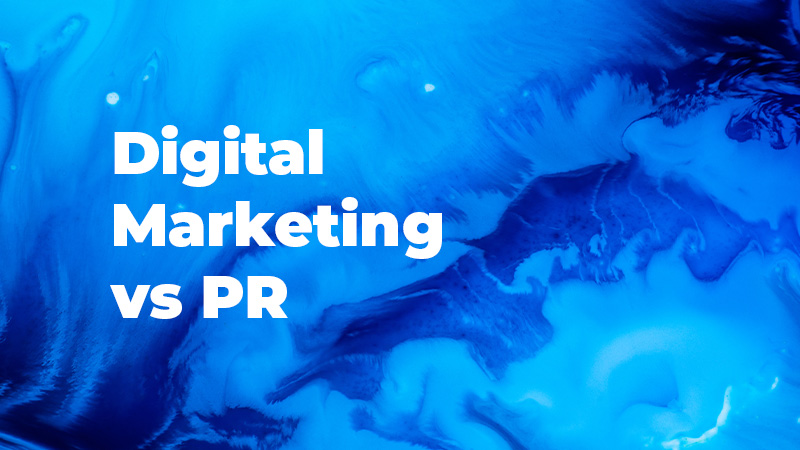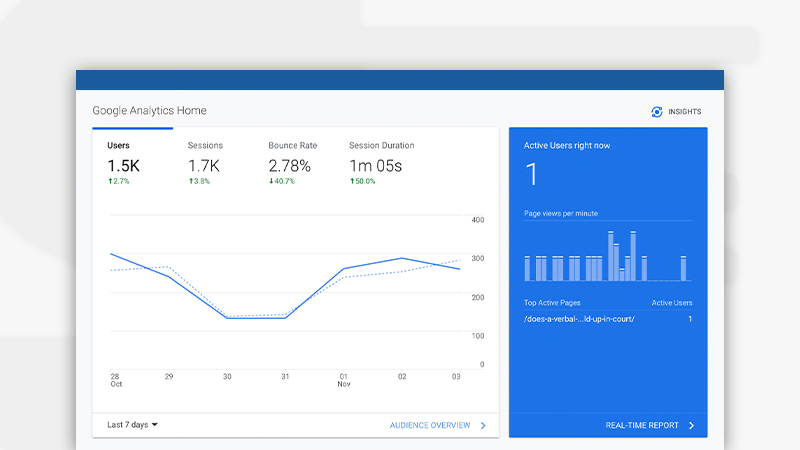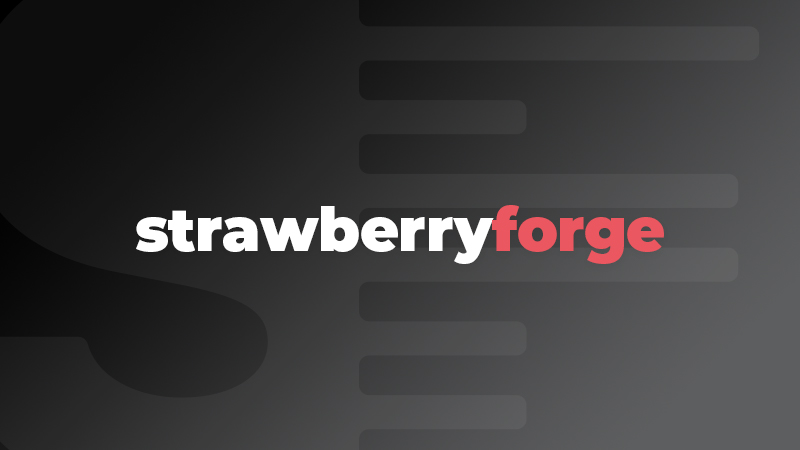One of the most frustrating aspects of business is having a great system for closing customers, but not enough leads coming in to generate meaningful growth.
Most businesses recognise the need for a website to provide a digital storefront that attracts prospective customers online, but this in itself will not be enough to create a regular stream of enquiries.
Why? Because the majority of visitors to your website will not be ready to purchase or even speak to your sales team. Since most company websites only target those ready to buy right now, a lot of potential leads fall through the cracks.
Think about your own website. I’ll bet you have a contact us page, and probably some kind of form where people can request a quote or something similar, but not much more than that. Am I right?
This is the first reason businesses struggle to generate leads online.They fail to capture the information of visitors who are looking for a solution, but not immediately ready to purchase.
As a result, a business can have thousands of website visitors, but only generate a handful of leads each month.
Sound familiar? If it does, it means your website is suffering from a lack of conversion rate optimisation (CRO). You don’t have the systems in place to effectively capture leads online.
A lack of leads can feel like a concrete ceiling blocking your business from its true potential. Don’t worry though, digital marketing is the sledgehammer that will break it.
This blog is going to show you a number of simple tricks you can use to quickly increase your CRO and generate more leads.
Before we do, though, let’s make sure we’re all on the same page.
What Exactly is Conversion Rate Optimisation?

Actually, before we answer that question we need to quickly define what we mean by ‘leads’. In short, there are a couple of types:
- Sales Qualified Leads (SQLs): SQLs are leads that are ready to purchase, and I’d be willing to bet that it’s these folks your website is currently set up to target.
- Marketing Qualified Leads (MQLs): MQLs are leads that aren’t ready to purchase straight away, but with the right nurturing, probably will be in the future. This is the type of lead you’re likely missing out on and who we’ll be focusing on capturing through CRO.
Okay, so you’re probably thinking “why should I care about MQLs? I need customers now.” That’s fair enough, but if you ignore MQLs, you’ll always in a position where you need customers right now. Generating MQLs helps you develop an idea of how much income you should expect in the future and plan accordingly.
Secondly, MQLs are in the process of researching which business can solve their challenge or need best, so you can bet that they’ll be checking out your competition as well. Without the right CRO strategy for capturing MQLs, you’ll more than likely lose them to a rival and they’ll never return as SQLs.
Okay, so now we’ve cleared that up, what do we mean by “capturing” a lead?
There are a few ways for a website visitor to become a lead, but by far the most common method is for a visitor to submit a form on your website and this is what we’ll be focusing on in this article. This means they give you their name and email address (as a minimum). In short, you’ve captured that lead.
So, how do you calculate your conversion rate? Here’s the formula:
(Number of Leads / Number of Unique Website Visitors) x 100 = Conversion Rate (%)
That means if you have 2000 monthly unique website visitors and produce 20 leads a month, your conversion rate is 1%.
Conversion rate optimisation is about increasing that number.
Here’s how you do it.
1. Delight Your Website Visitors

If you only remember one thing from this article, I want it to be this: CRO starts the second someone engages with your business digitally, whether that be on your website, social or via email.
It’s important then to recognise that you can implement every tactic and technique I’m going to share with you, but if you forget to deliver value to your users, you won’t see an increase in your conversion rate.
Delighting your visitors really comes down to two elements. I’m going to speak about them in relation to your website, but the same principles can largely be applied to your social media, email and any other type of digital marketing you can think of.
Content
When I started out in marketing, I used to wonder if there was some kind of rule book that said every blog had to talk about content. Everywhere I looked people were talking about the importance, and I won’t lie, I got a little sick of it.
If that’s how you’re currently feeling I can only apologise for bringing it up again. The problem is, great content really is vital to online marketing success. If you don’t have it, it’s like trying to run a body without blood. It just doesn’t work.
Content is particularly important to CRO because you’re asking people to give up personal details like their name and email. That kind of information is important, so website users won’t just give it to anyone. They need to trust you.
Since their first impression of your business will come from your content, it’s important to immediately gain their trust by delivering value to them.
The best way to do this is through blogs. If you can introduce website visitors to your business through a blog, you have total licence to put your agenda to the side and focus entirely on providing useful content.
How you do this will depend on whether your a B2B or B2C company. If you’re B2B, research trends in your target market and provide expert insight into them. If you’re B2C, think about what your visitors want to read about that relates to your service. For example, a property developer might write a blog about space-saving techniques.
Whatever you write about, keep it focused on what your website visitor wants, not what you want. To do this, I’d actually recommend writing yourself out of the blog. Unless you have good reason to, don’t talk too much about your products or services. This will help your blog not to feel salesy.
The best bit about blogging is that not only will it help improve your CRO, but it’ll also generate you more website visitors, which will result in more leads and, ultimately, more customers.
User Experience
Alongside content, the user experience (UX) of your website will have a big impact on how visitors first engage with your website and whether they convert.
We’ve all become used to a high-quality online experience, which means we’re impatient when a website does not meet our expectations. A good example of this is website page speeds.
A lot of research has been done on the impact of page speed on bounce rate (the rate that people leave your site without interacting with it), and this is a nice example from section.io.
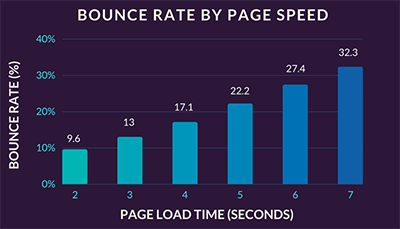
It’s clear to see that a slow page load speed results in more people leaving your website. As I said, we’ve become impatient and no one wants to hang around for a slow website.
However, page speed isn’t the only thing that makes a good or bad user experience. You’ll also want to pay special attention to the…
- Design of your website: Use white space to break up content and make your website more inviting.
- Use of images: Use high-quality images to convey professionalism and make your website more visually engaging.
- Colour and typography: Use contrasting colours to draw attention to important areas of your website and an easy to read typography to convey information effectively.
Of course, there are many aspects of UX you’ll want to consider as part of your CRO strategy, but if you start with the ones described you’ll be on the way to improving lead generation. Want to take a look at how your website is currently performing? Use HubSpot’s Website Grader.
2. Develop User Pathways

At the beginning of this article, I spoke about how most websites only have a couple of ways a website visitor can convert, such as a contact us page or request a quote form. In a little while, I’m going to talk about how you can make multiple conversion points, but before I do, it’s important to consider how you expect users to navigate your website.
After all, a website can be made up of hundreds or even thousands of individual pages. Without a clear strategy for how a user finds a specific conversion point, you won’t see an improvement in conversion rate.
With this in mind, I’m going to share two pieces of information, both designed to make the transition from website visitor to lead as seamless as possible. This is called implementing user pathways.
Website Structure

Website structure really just comes down to ensuring your website is easy to navigate for users. If you have a list of services on your website, are they easily accessible for someone who is new to the site? If they aren’t, what is the point in having them if no one can find them?
So, if you’ve not considered your website sitemap lately, it’s time to do so now. A sitemap is exactly what it sounds like – a map of your website.
Starting with your top-level navigation items, you can plan out how pages link to one another. Here’s an example:
On your sitemap, you might have a top-level item called ‘Services’. This is the page that would appear on your navigation menu.
Below ‘Services’ in your sitemap, you might have a second-level page, relating to a specific service you provide. If you were an estate agent, it could be something like ‘Property Valuation’.
This second-level item would need to be linked to via the page ‘Services’ and could also appear as a submenu item.
Finally, you might have a third level page called ‘Book a Property Valuation’. This probably wouldn’t make it to your main website menu, and so would need to be prominently linked to on the ‘Property Valuation’ page.
This is a very simple example of one element of a full site structure, but you can see that conversion point, ‘Book a Property Valuation’ can easily be found in just a couple of clicks. In fact, the number of clicks is a good metric by which to measure the effectiveness of your CRO. If property valuations are your main focus, aim for one click!
Ensuring your website is well structured and easy to navigate will ensure that users don’t become lost in your website and leave.
If you only have a small number of pages on your website, chances are your structure is pretty simple, but as your website grows, this will not always be the case.
Taking the time early to map out where you want visitors to go when they land on your website will save you a lot of time in the future.
Of course, sometimes you’ll just want to throw up a massive sign on your website that screams “click here”. Luckily, there’s a tool for that…
Calls-to-Action (CTAs)
A call-to-action is an element on your website that motivates users to make a specific action. Most commonly, you’ll see a CTA in the form of a button or image.
Including CTAs on your website pages and blogs is an effective way of ensuring your visitors can find your conversion points without too much effort.
CTAs also mean that you have an influence on what information they engage with. For example, if a website visitor enters your website on a blog about sofa design, your CTA can help them find a conversion point that relates to the topic they read about on your blog, such as an eBook on interior design.
One of the goals of your CRO strategy should be to move someone from being a website visitor to a lead as quickly as possible. CTAs are a useful tool for this, as they help you move people to a form quickly and before they lose interest.
Alongside blogs, CTAs are best used on your homepage to direct people to a high-value conversion point. You can see an example of this from Dropbox below.
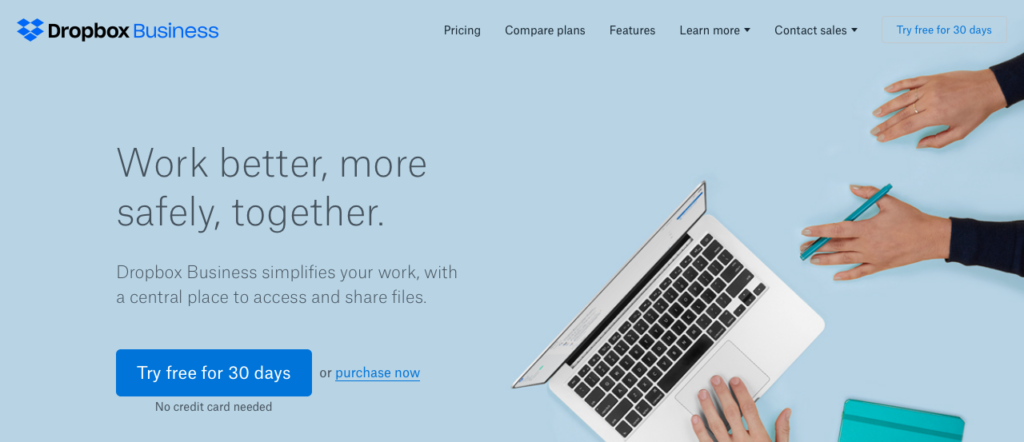
Here, the CTA is the “Try free for 30 days” button. While Dropbox recognises that some people will want to buy straight away, they have identified that they have a high conversion rate by using a trial offer. This allows people to see the value of the software and makes the decision to purchase easy.
CTAs are easy to develop and can have a drastic rate on your CRO. Just ensure that when you use them, you have access to analytics to see how much the CTA is being used. You can then test different wording, images and colours to improve your CRO.
3. Drive Form Submissions
We’ve spent a lot of time speaking about how you can ensure website visitors find conversion points quickly and easily. Now it’s time to look at how you actually make those conversion points.
Just to clarify though, a conversion point is a page on your website where the sole purpose is for a person to provide their information to you. Your conversion points should have no other purpose, as doing so presents an option to users that will damage your CRO.
Conversion points are one of the most important elements of your website, so you’ll need to get them right. To do so, you’ll need to master three things.
Offers

As mentioned, giving up their name and email is a big step for a website visitor and not one you should expect them to take for free. Therefore, you’ll need to propose a trade.
If you’ve implemented the previous steps in this article effectively, your website visitors should arrive at your conversion points already having experienced the value of your content. As such, they’re likely to trust you when you present them an offer.
An offer can be anything that delivers a large amount of value to a user for free. Examples include:
- eBooks
- Discounts
- Consultations
- Webinars
- Video Tutorials
- Infographics
- Memberships
The list goes on and can include anything that you think will be of value to your target market. The important thing is that the offer is free. Of course, it isn’t, as visitors are paying with their details, but there is no monetary value.
I’ve downloaded 200-page books for free as part of this process, simply because the value it delivers me is huge and it is from a brand I trust. That makes the decision about whether I want a business to have my email an easy one.
Forms
If you want to gather information and convert visitors to leads, you need a system for doing so. This is where forms come in.
You may be thinking that forms are so simple, what is there to possibly say? Well, you’re right. Forms are pretty basic, so I’ll keep this section short, but there are a couple of tips you can use to improve their performance.
The first tip is to consider how much information you should ask for on a form in relation to the value of the offer you’re giving away.
If you’re giving away a free infographic, this won’t provide as much value as a discount voucher, so the forms shouldn’t be treated the same. The form for your infographic should be short and not ask for too much information, otherwise, people won’t see it as a fair trade.
Conversely, if you’re giving away something as valuable as a discount, make sure you get your money’s worth by asking for detailed information.
Bear in mind as well that people may submit multiple forms on your website. In this instance, you don’t want to be asking for the same information every time, as you’re limiting the data you can pass onto your sales team.
Software like HubSpot allows you to create progressive fields, meaning that once a user as filled in a piece of information, that form field is replaced by a new one on other forms.
For example, two forms might both ask for a job title, but by the time you come to the second form, that field has changed to ask for something else, like a phone number.
In this way, progressive fields allow you to learn something new each time a lead submits a form on your website.
Landing Pages
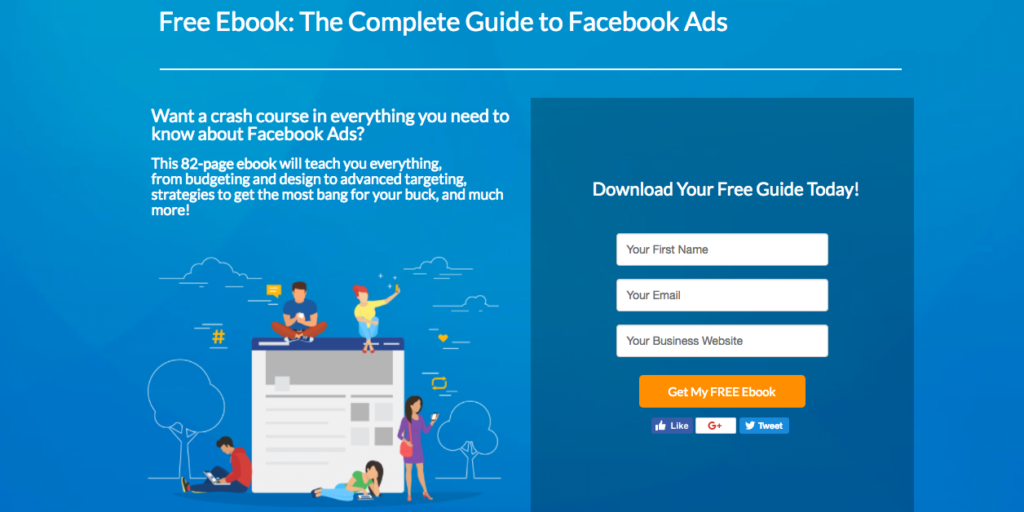
The final step to creating a conversion point and improve your CRO is to host your offer and form on a landing page.
Unlike a normal website page, a landing page does not show your usual menu bar. Likewise, a landing page does not include any links to other web pages or websites.
As such a landing page forces a user to make a decision: leave your website; return to the homepage via the logo, or submit your form.
This may seem a little tough, but what a landing page really does is eliminate any distractions for a user. The page should contain all the information required to demonstrate the value of the offer your sharing, and the form should be prominently placed to provide a clear action for the user to take.
With a fully optimised landing page, your website visitors will be driven to submit your form, and you’ll see your lead numbers rise.
4. Build on Your Success

By following each of the steps laid out in this article, you’ll be able to effectively improve your conversion rate optimisation and benefit from more leads and customers.
The work doesn’t stop there though. The real secret to CRO is never stopping.
How users engage with your website and the internet as a whole is always changing, therefore you need to constantly be analysing and improving your CRO strategy.
It makes sense then that the first step to your CRO strategy should be reviewing your existing website performance and looking for improvements.
For this, there is no substitute for a fresh, expert perspective, and that’s exactly what we’re offering.
You can book a free Digital Workshop with our team to learn the latest techniques that we’re using to improve our CRO and how you can do the same.



